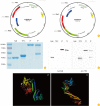Tetanus toxin fragment C fused to flagellin makes a potent mucosal vaccine
- PMID: 25649002
- PMCID: PMC4313110
- DOI: 10.7774/cevr.2015.4.1.59
Tetanus toxin fragment C fused to flagellin makes a potent mucosal vaccine
Abstract
Purpose: Recombinant subunit vaccines provide safe and targeted protection against microbial infections. However, the protective efficacy of recombinant subunit vaccines tends to be less potent than the whole cell vaccines, especially when they are administered through mucosal routes. We have reported that a bacterial flagellin has strong mucosal adjuvant activity to induce protective immune responses. In this study, we tested whether FlaB could be used as a fusion partner of subunit vaccine for tetanus.
Materials and methods: We constructed fusion proteins consisted with tetanus toxin fragment C (TTFC), the nontoxic C-terminal portion of tetanus toxin, and a Toll-like receptor 5 agonist from Vibrio vulnificus (FlaB). Mice were intranasally administered with fusion protein and protective immune responses of the vaccinated mice were analyzed.
Results: FlaB-TTFC recombinant protein induced strong tetanus-specific antibody responses in both systemic and mucosal compartments and prolonged the survival of mice after challenge with a supra-lethal dose of tetanus toxin.
Conclusion: This study establishes FlaB as a successful fusion partner for recombinant subunit tetanus vaccine applicable through mucosal route, and it further endorses our previous observations that FlaB could be a stable adjuvant partner for mucosal vaccines.
Keywords: Adjuvant; Flagellin; Subunit vaccine; Tetanus toxin fragment C.
Conflict of interest statement
No potential conflict of interest relevant to this article was reported.
Figures




Similar articles
-
Tetanus Toxin Fragment C: Structure, Drug Discovery Research and Production.Pharmaceuticals (Basel). 2022 Jun 17;15(6):756. doi: 10.3390/ph15060756. Pharmaceuticals (Basel). 2022. PMID: 35745675 Free PMC article. Review.
-
A bacterial flagellin, Vibrio vulnificus FlaB, has a strong mucosal adjuvant activity to induce protective immunity.Infect Immun. 2006 Jan;74(1):694-702. doi: 10.1128/IAI.74.1.694-702.2006. Infect Immun. 2006. PMID: 16369026 Free PMC article.
-
Intranasal immunization with recombinant PspA fused with a flagellin enhances cross-protective immunity against Streptococcus pneumoniae infection in mice.Vaccine. 2011 Aug 5;29(34):5731-9. doi: 10.1016/j.vaccine.2011.05.095. Epub 2011 Jun 13. Vaccine. 2011. PMID: 21696869
-
Norovirus (NoV) specific protective immune responses induced by recombinant P dimer vaccine are enhanced by the mucosal adjuvant FlaB.J Transl Med. 2016 May 17;14(1):135. doi: 10.1186/s12967-016-0899-4. J Transl Med. 2016. PMID: 27184355 Free PMC article.
-
Intranasal administration of a flagellin-adjuvanted inactivated influenza vaccine enhances mucosal immune responses to protect mice against lethal infection.Vaccine. 2012 Jan 5;30(2):466-74. doi: 10.1016/j.vaccine.2011.10.058. Epub 2011 Oct 31. Vaccine. 2012. PMID: 22051136
Cited by
-
Mucosal immunization with a flagellin-adjuvanted Hgp44 vaccine enhances protective immune responses in a murine Porphyromonas gingivalis infection model.Hum Vaccin Immunother. 2017 Dec 2;13(12):2794-2803. doi: 10.1080/21645515.2017.1327109. Epub 2017 Jun 12. Hum Vaccin Immunother. 2017. PMID: 28604268 Free PMC article.
-
Conjugation of wildtype and hypoallergenic mugwort allergen Art v 1 to flagellin induces IL-10-DC and suppresses allergen-specific TH2-responses in vivo.Sci Rep. 2017 Sep 18;7(1):11782. doi: 10.1038/s41598-017-11972-w. Sci Rep. 2017. PMID: 28924222 Free PMC article.
-
The efficacy of alcelaphine herpesvirus-1 (AlHV-1) immunization with the adjuvants Emulsigen® and the monomeric TLR5 ligand FliC in zebu cattle against AlHV-1 malignant catarrhal fever induced by experimental virus challenge.Vet Microbiol. 2016 Nov 15;195:144-153. doi: 10.1016/j.vetmic.2016.09.019. Epub 2016 Sep 23. Vet Microbiol. 2016. PMID: 27771060 Free PMC article.
-
Tetanus Toxin Fragment C: Structure, Drug Discovery Research and Production.Pharmaceuticals (Basel). 2022 Jun 17;15(6):756. doi: 10.3390/ph15060756. Pharmaceuticals (Basel). 2022. PMID: 35745675 Free PMC article. Review.
-
NFκB- and MAP-Kinase Signaling Contribute to the Activation of Murine Myeloid Dendritic Cells by a Flagellin A:Allergen Fusion Protein.Cells. 2019 Apr 15;8(4):355. doi: 10.3390/cells8040355. Cells. 2019. PMID: 30991709 Free PMC article.
References
-
- Plotkin SA, Plotkin SL. The development of vaccines: how the past led to the future. Nat Rev Microbiol. 2011;9:889–893. - PubMed
-
- Unnikrishnan M, Rappuoli R, Serruto D. Recombinant bacterial vaccines. Curr Opin Immunol. 2012;24:337–342. - PubMed
-
- Campbell JD, Clement KH, Wasserman SS, Donegan S, Chrisley L, Kotloff KL. Safety, reactogenicity and immunogenicity of a recombinant protective antigen anthrax vaccine given to healthy adults. Hum Vaccin. 2007;3:205–211. - PubMed
-
- Pizza M, Covacci A, Bartoloni A, et al. Mutants of pertussis toxin suitable for vaccine development. Science. 1989;246:497–500. - PubMed
LinkOut - more resources
Full Text Sources
Other Literature Sources

